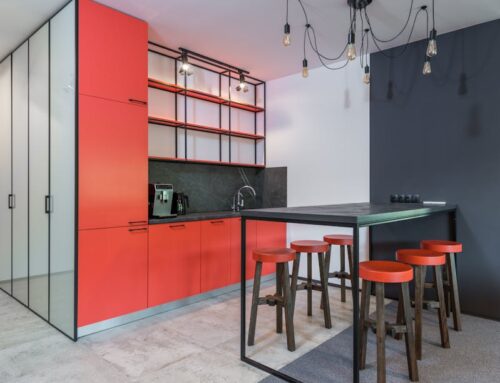Introduction to color psychology
Color psychology plays a significant role in creating a harmonious and inviting atmosphere in your home. Different colors evoke different emotions and can influence our mood and behavior. For instance, warm colors like red and orange can create a cozy and energetic ambiance, perfect for social spaces like living rooms and dining areas. On the other hand, cool colors like blue and green can promote a sense of calm and relaxation, making them ideal for bedrooms and home offices. By understanding the principles of color psychology, you can strategically choose colors that align with the desired mood and function of each room in your home, creating a space that not only looks beautiful but also feels welcoming and soothing.

How color affects mood and emotions
Color has a powerful impact on our mood and emotions, and it plays a significant role in creating the desired atmosphere in our homes. Different colors have the ability to evoke specific feelings and emotions within us. For example, warm colors such as red and orange can create a sense of energy and excitement, while cool colors like blue and green can promote relaxation and calmness. By understanding the principles of color psychology, homeowners can strategically choose colors for their walls, furniture, and decor to create the desired ambiance and enhance their overall well-being. Whether you want to create a cozy and inviting space or a vibrant and stimulating environment, harnessing the power of color can transform your home into a sanctuary that reflects your unique personality and positively influences your emotions.
The importance of choosing the right colors for your home
Choosing the right colors for your home is more than just a matter of personal preference. It has a significant impact on the overall atmosphere and mood of your living space. Color psychology, the study of how colors affect human behavior and emotions, plays a crucial role in home design. For example, warm colors like red and orange can create a sense of energy and excitement, while cool colors like blue and green promote relaxation and calmness. By understanding the psychological effects of different colors, you can create a harmonious and inviting environment that reflects your unique style and enhances your well-being.
Warm colors and their effects on the mind and body
Warm colors, such as red, orange, and yellow, have a powerful impact on our mind and body. These colors are known to evoke feelings of warmth, energy, and excitement. When used in home decor, warm colors can create a welcoming and cozy atmosphere. They have the ability to stimulate our appetite and encourage social interaction, making them a great choice for dining rooms and living areas. Additionally, warm colors can also increase our heart rate and blood pressure, which can be beneficial for those looking to create a lively and energetic space. By understanding the impact of warm colors, you can strategically use them in your home to create the desired mood and ambiance.
Cool colors and their effects on the mind and body
Cool colors, such as blues and greens, can have a profound impact on our mind and body when used in our home. These colors are known for their calming and soothing effects, making them perfect for spaces where relaxation and tranquility are desired, such as bedrooms and bathrooms. Cool colors have been shown to lower blood pressure, reduce stress levels, and promote a sense of serenity. Additionally, these colors can visually expand a space, making it feel larger and more open. By incorporating cool colors into your home, you can create a peaceful and harmonious environment that promotes overall well-being.
Neutral colors and their effects on the mind and body
Neutral colors, such as beige, gray, and white, have a significant impact on the mind and body in your home. While often considered safe or boring, these colors actually promote a sense of calm and tranquility. Beige, for example, is associated with warmth and stability, making it an ideal choice for living rooms or bedrooms. Gray, on the other hand, evokes a sense of sophistication and elegance, making it perfect for office spaces or dining areas. White, with its purity and simplicity, creates a feeling of cleanliness and openness, making it popular in bathrooms and kitchens. By incorporating neutral colors into your home, you can create a harmonious environment that promotes relaxation and well-being.
How to choose the right colors for each room in your home
Choosing the right colors for each room in your home can have a significant impact on the atmosphere and mood. Color psychology plays a crucial role in creating a harmonious and balanced space. For example, cool colors like blue and green can promote calmness and relaxation, making them ideal for bedrooms and bathrooms. On the other hand, warm colors like red and orange can stimulate energy and creativity, making them suitable for living rooms and home offices. It is important to consider not only personal preferences but also the function and purpose of each room when selecting colors. By understanding the psychology behind colors, you can create a home environment that not only looks visually appealing but also enhances your overall well-being.
Using color psychology to create a specific atmosphere or style
Color psychology plays a significant role in creating a specific atmosphere or style in your home. Each color has its own unique psychological effect on our mood and emotions. For instance, warm colors like red and orange can stimulate energy and create a cozy and inviting ambiance. On the other hand, cool colors such as blue and green can promote calmness and relaxation, perfect for creating a serene and tranquil environment. By understanding the impact of different colors, you can strategically use them in your home decor to evoke specific feelings and set the desired tone for each room. Whether you want to create a vibrant and energetic space or a peaceful and soothing retreat, harnessing the power of color psychology can transform your home into a haven that reflects your personal style.
Tips for incorporating color psychology into your home decor
Color psychology plays a significant role in creating a harmonious and balanced atmosphere in your home. By understanding the emotional and psychological effects of different colors, you can effectively incorporate them into your home decor to create the desired ambiance. For example, warm colors like red and orange can promote energy and passion, making them ideal for social spaces like the living room or dining area. On the other hand, cool colors like blue and green have a calming effect, making them perfect for bedrooms or study areas. By carefully selecting and combining colors, you can create a space that not only looks visually appealing but also enhances your mood and well-being.
Conclusion and final thoughts
Color psychology plays a significant role in creating the desired atmosphere and ambiance in your home. The colors you choose for your walls, furniture, and decor can have a profound impact on your mood, emotions, and overall well-being. Warm colors like red and orange can evoke feelings of energy and passion, while cool colors like blue and green can promote a sense of calm and relaxation. Additionally, color combinations and contrasts can create visual interest and balance in your space. By understanding the principles of color psychology, you can strategically use color in your home to enhance certain moods, promote productivity, or create a cozy and inviting atmosphere. So when it comes to designing your home, don’t underestimate the power of color.



